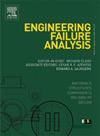Analysis of erosion characteristics of Al2O3-SiC-SiO2-C castable-poured in blast furnace hearth
IF 4.4
2区 工程技术
Q1 ENGINEERING, MECHANICAL
引用次数: 0
Abstract
This paper investigates erosion behaviors of Al2O3-SiC-SiO2-C (ASSC) castable refractory in a 2650 m3 blast furnace hearth. Post-service residual thickness measurements, conducted via 3D laser scanning and manual gauging across multiple hearth orientations with radial sampling at 8.7 m and 6.7 m elevations, revealed critical erosion zones at the “elephant foot” region (1.5–2 m below taphole centerline) and furnace bottom. Minimum residual thicknesses were recorded at 300 mm (sidewall) and 160 mm (bottom), with erosion rates reaching 81.99 % (314.6 mm/yr) and 84.00 % (168.0 mm/yr), respectively. The 3D erosion profile exhibited a distinctive “shallow pot-bottom” morphology, where measured thicknesses exceeded theoretical predictions by approximately 50 mm. Scanning Electron Microscopy-Energy Dispersive Spectroscopy (SEM-EDS) analysis elucidated erosion mechanisms: The taphole area exhibited tri-layered degradation from molten iron, slag, and harmful elemental penetration, while the elephant foot region showed predominant iron and elemental infiltration. Design recommendations include increasing ASSC layer thickness in taphole and elephant foot zones, along with thermocouple integration for real-time monitoring. Operational strategies to prolong refractory lifespan involve maintaining saturated carbon/silicon content in hot metal, controlling charge impurities, and implementing regular alkali removal protocols. These findings provide mechanistic insights for optimizing hearth design and operational practices in large-scale blast furnaces.
高炉炉底浇注Al2O3-SiC-SiO2-C浇注料的侵蚀特性分析
本文研究了Al2O3-SiC-SiO2-C (ASSC)浇注耐火材料在2650 m3高炉炉底的侵蚀行为。使用后残余厚度测量,通过三维激光扫描和手动测量在8.7 m和6.7 m海拔的多个炉膛方向径向取样,揭示了“象脚”区域(在出料口中心线以下1.5-2 m)和炉底的临界侵蚀区域。最小残留厚度分别为300 mm(侧壁)和160 mm(底部),侵蚀率分别为81.99% (314.6 mm/yr)和84.00 % (168.0 mm/yr)。三维侵蚀剖面呈现出独特的“浅罐底”形态,测量厚度超过理论预测约50毫米。扫描电镜-能谱(SEM-EDS)分析表明:铁液、矿渣和有害元素渗透对喷口区域的侵蚀呈三层状,而象足区则以铁和元素渗透为主。设计建议包括增加出水口和象足区域的ASSC层厚度,以及热电偶集成以进行实时监控。延长耐火材料寿命的操作策略包括保持铁水中碳/硅的饱和含量,控制电荷杂质,以及执行常规的除碱方案。这些发现为优化大型高炉炉底设计和操作实践提供了机理见解。
本文章由计算机程序翻译,如有差异,请以英文原文为准。
求助全文
约1分钟内获得全文
求助全文
来源期刊

Engineering Failure Analysis
工程技术-材料科学:表征与测试
CiteScore
7.70
自引率
20.00%
发文量
956
审稿时长
47 days
期刊介绍:
Engineering Failure Analysis publishes research papers describing the analysis of engineering failures and related studies.
Papers relating to the structure, properties and behaviour of engineering materials are encouraged, particularly those which also involve the detailed application of materials parameters to problems in engineering structures, components and design. In addition to the area of materials engineering, the interacting fields of mechanical, manufacturing, aeronautical, civil, chemical, corrosion and design engineering are considered relevant. Activity should be directed at analysing engineering failures and carrying out research to help reduce the incidences of failures and to extend the operating horizons of engineering materials.
Emphasis is placed on the mechanical properties of materials and their behaviour when influenced by structure, process and environment. Metallic, polymeric, ceramic and natural materials are all included and the application of these materials to real engineering situations should be emphasised. The use of a case-study based approach is also encouraged.
Engineering Failure Analysis provides essential reference material and critical feedback into the design process thereby contributing to the prevention of engineering failures in the future. All submissions will be subject to peer review from leading experts in the field.
 求助内容:
求助内容: 应助结果提醒方式:
应助结果提醒方式:


